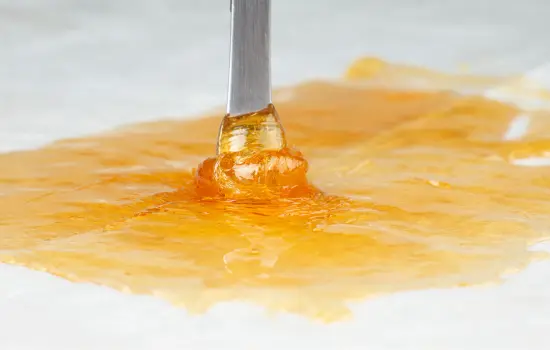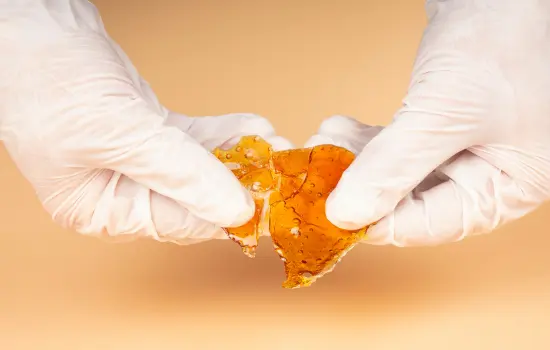Introduction
What is Weed Wax?
Definition
Texture and Appearance
Common Names
- Budder: Smooth and buttery texture.
- Crumble: Dry, flaky, and easy to handle.
- Honeycomb: A porous structure resembling a honeycomb.
- Live Resin: Known for retaining fresh plant terpenes, giving it a strong aroma and flavor.
THC Concentration

How is Weed Wax Made?
Overview of the Extraction Process
Purging Process to Remove Residual Solvents
Safety Concerns During Production
Role of Professional Labs for Quality and Safety
Types of Weed Wax
1. Budder: Smooth, Creamy Texture
2. Crumble: Dry and Crumbly Consistency
3. Shatter: Glass-like, Hard Texture
4. Live Resin: Fresh Flavor and Aroma
Risks and Considerations
1. Potential for Overconsumption Due to High THC Content
2. Importance of Dosage Control for New Users
3. Health Concerns Related to Improper Extraction Methods
4. Legal Status in Various Regions
Weed Wax vs. Other Cannabis Products
1. Potency
- Weed Wax: Known for its exceptionally high THC levels (60%-90%), weed wax is significantly more potent than most other cannabis products. A small amount can deliver intense effects, making it a favorite among experienced users seeking a powerful high.
- Flower: Traditional cannabis flower typically contains 15%-25% THC, making it much less potent than weed wax. It’s a better choice for beginners or those who prefer milder effects.
- Edibles: While edibles can also deliver strong effects, the THC concentration is typically lower per serving. The potency depends on the dosage, but the effects are often delayed compared to inhaled products.
- Oils and Tinctures: Cannabis oils and tinctures vary in potency, but they generally fall between flower and wax in terms of strength. They are more versatile for dosing and can be consumed sublingually or mixed with food.
2. Consumption Methods
- Weed Wax: Consumed primarily through dabbing or vaporizing, which involves using a dab rig or specialized vaporizer for concentrates. It can also be sprinkled on flower for an extra kick.
- Flower: Smoked or vaporized using traditional methods like joints, pipes, or dry herb vaporizers.
- Edibles: Ingested orally, often in the form of gummies, baked goods, or beverages. No inhalation is required, making it a discreet option.
- Oils and Tinctures: Consumed sublingually (placed under the tongue) for faster absorption or added to food and drinks for a delayed effect.
3. Effects
- Weed Wax: Delivers immediate and intense effects due to its high potency and rapid absorption when inhaled. It’s ideal for users seeking a quick and powerful experience.
- Flower: Offers a more balanced and gradual onset of effects, making it suitable for casual use or first-timers.
- Edibles: Effects take longer to kick in (30-90 minutes) but last much longer, often providing a deeper body-focused experience.
- Oils and Tinctures: Effects depend on the method of consumption. Sublingual use offers faster onset, while ingestion provides a delayed but prolonged experience.
4. Differences in Texture and Form
- Weed Wax: Sticky, waxy consistency, available in various textures like budder, crumble, and live resin.
- Flower: Flower: Raw plant material that must be ground and prepared for use.
- Edibles: Pre-made consumables like candies or baked goods with a specific THC dose.
- Oils and Tinctures: Liquid form, often supplied with a dropper for precise dosing.
Key Takeaway
Legal and Safety Considerations
1. Check Local Laws Before Purchasing or Using Weed Wax
- The legal status of weed wax varies greatly depending on where you live. In some regions, it is fully legal for recreational and medical use, while in others, it may be restricted or outright prohibited.
- Laws may also regulate how much you can possess, where you can use it, and whether concentrates like weed wax are treated differently from cannabis flower.
- Always research the cannabis laws in your area before purchasing or using weed wax to avoid legal complications.
2. Importance of Buying from Licensed Dispensaries for Safe Products
- Purchasing weed wax from licensed dispensaries is crucial for ensuring the product’s quality and safety.
- Licensed dispensaries are required to test their products for potency, residual solvents, pesticides, and other contaminants, ensuring that what you consume is free from harmful substances.
- Avoid buying weed wax from unverified or illegal sources, as these products may be improperly made and contain dangerous residues from the extraction process.

3. Safety Tips for Storage and Handling
- Storage: Keep weed wax in a cool, dark place, preferably in an airtight container, to maintain its potency and freshness. Silicone containers are ideal for sticky concentrates like wax, as they prevent mess and make handling easier.
- Childproofing: Always store weed wax out of reach of children and pets. Use child-resistant containers if possible, and label them clearly to avoid accidental consumption.
- Handling: Use the right tools, such as dabbers or concentrate applicators, to minimize waste and avoid direct contact with the wax. This ensures proper dosing and maintains hygiene.
- Hygiene: Always clean your tools and hands before and after handling weed wax to prevent contamination.
Conclusion
FAQs About Weed Wax
What is weed wax?
Weed wax is a concentrated form of cannabis with a sticky, wax-like consistency. It is created through an extraction process that isolates THC and other cannabinoids, resulting in a highly potent product.
What are the risks of using weed wax?
The main risks include overconsumption due to its high THC content, potential health concerns from improperly made wax, and legal restrictions in certain regions. New users should start with small doses to avoid overwhelming effects.
How does weed wax compare to other cannabis products?
Weed wax is significantly more potent than cannabis flower, edibles, or oils. Its effects are fast-acting when inhaled and intense, making it ideal for experienced users or those seeking strong effects in smaller doses.
Is weed wax legal everywhere?
No, the legality of weed wax varies by location. In some places, it is legal for medical or recreational use, while in others, it is restricted or prohibited. Always check local cannabis laws before purchasing or using weed wax.
What are the different types of weed wax?
Weed wax comes in various forms, including budder (smooth and creamy), crumble (dry and flaky), shatter (glass-like and hard), and live resin (rich in flavor and aroma). Each type offers a unique texture and user experience.







